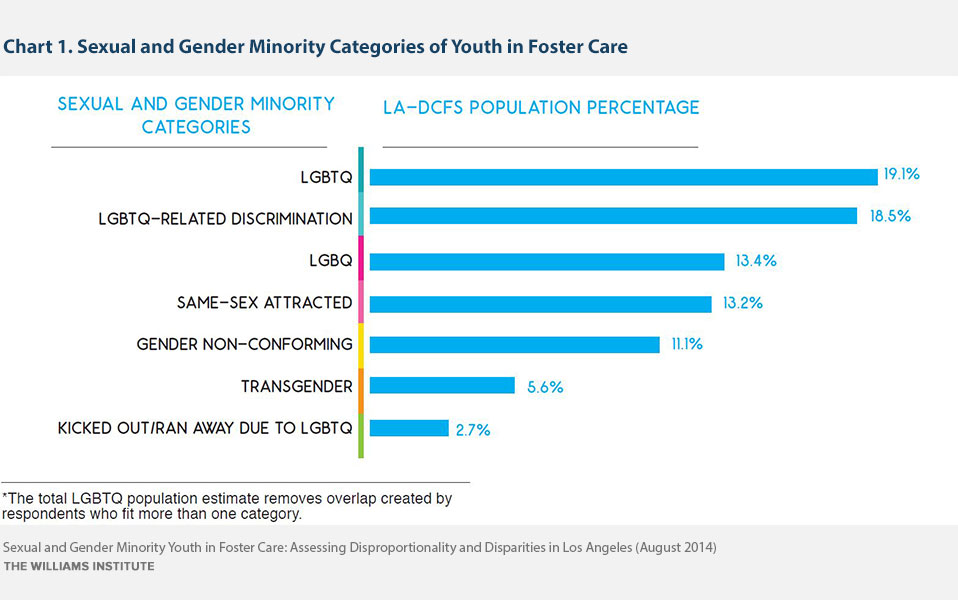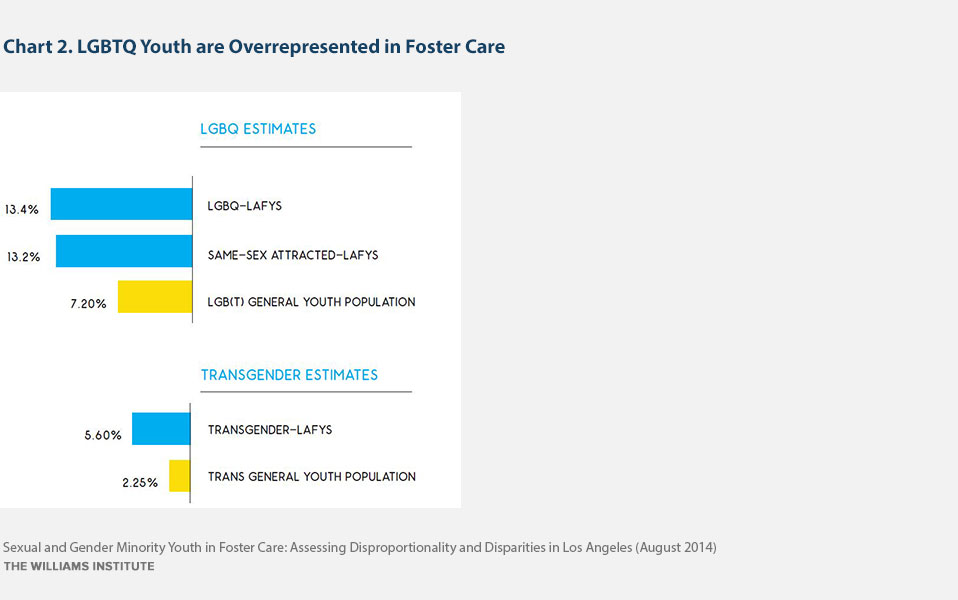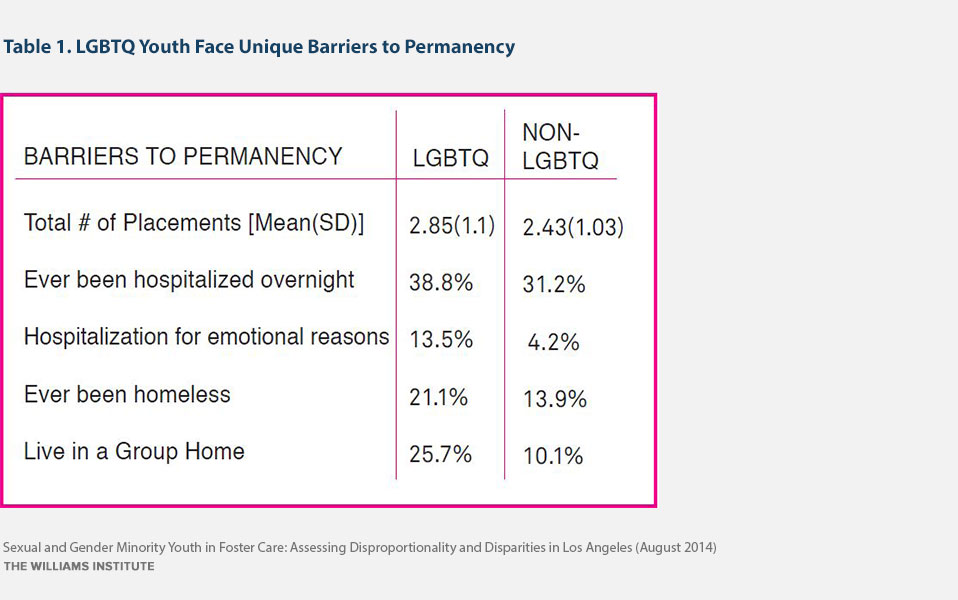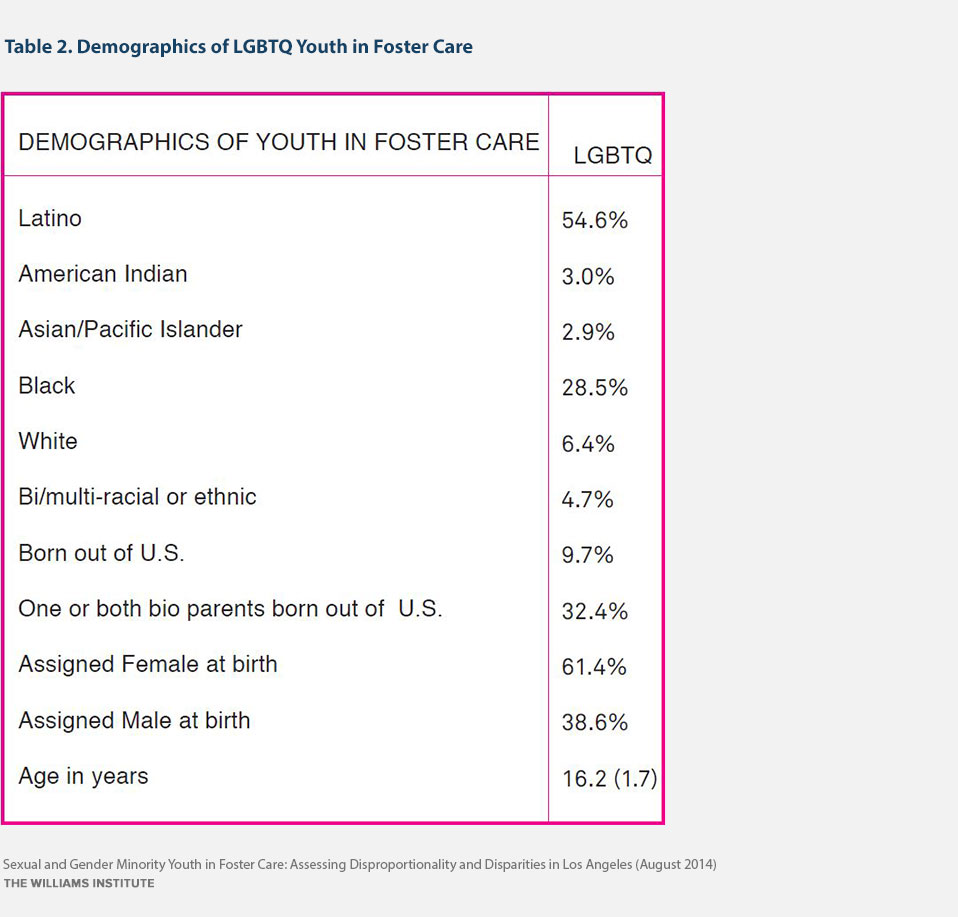Introduction
The Los Angeles County Child Welfare System has a duty to protect foster care youth from harm and to act in their best interests. In order for the system to fulfill its duty, there is a need to understand who is in the system and how different groups of youth may face unique challenges. Lesbian, gay, bisexual, transgender and questioning (LGBTQ), and other sexual and gender minority youth are one such group. At various points during their time in the child welfare system, LGBTQ youth interact with caseworkers, foster parents, congregate care facility employees, and other foster youth. In these interactions, LGBTQ youth may experience discrimination and stigma unique to their sexual orientation, gender identity and/or gender expression. However, an overall lack of systematic data collection on LGBTQ youth in foster care limits the ability of the child welfare system to address the unique challenges of this group.
For over three decades, research on adolescent demographic characteristics and behavior has been conducted via school-wide, state, or national surveys, many of which have included questions about sexual orientation. More recently, there have also been efforts to integrate measures of gender identity and expression into large scale surveys. Though past studies likely included youth in foster care, they did not specifically focus on foster care youth, nor did they include questions about dependency status. This makes it difficult to answer “How many youth in foster care are LGBTQ?” Similarly, while there has been research on the factors that may lead youth to enter or remain in foster care, such as family rejection or physical and verbal abuse, there is a lack of population-based research on the outcomes of those youth once they enter care. This makes it difficult to answer, “How are LGBTQ youth doing in foster care?”
Implications for Policymakers & Caregivers
Policymakers and caregivers can take steps to better understand the lives and unique challenges of the LGBTQ youth they serve.
Data Collection
Despite their overrepresentation among foster care youth, LGBTQ youth have been relatively invisible within the system because of barriers to disclosure and a lack of data collection. To address this:
- Integrate questions about sexual orientation, gender identity, gender conformity, and discriminatory experiences related to these social statuses into existing demographic data collection, intake, service planning and case review processes.
- Raise the competencies of child welfare workers to collect this information respectfully and accurately prior to integrating these questions in systems.
- Make sure to maintain confidentiality when sharing and recording this information prior to integrating these questions in systems.
Address oppressions
Improving permanency outcomes for LGBTQ youth requires a multi-pronged approach that examines how oppressions operate at structural and institutional levels (e.g., within policies, families, public spaces, and organizations), as well as at the level of interpersonal and workforce interactions.
- Address LGBTQ competencies within the child welfare system workforce and among caregivers.
- Address the roles that racism, heterosexism, and anti-trans-bias play in creating disparities for LGBTQ youth in foster care.
Cost Avoidance
LGBTQ youth in this sample were particularly overrepresented in group home settings, moved significantly more, and were hospitalized for emotional reasons at a higher rate. This all means additional costs – higher rates paid for extensive group care stays and hospital stays, and additional administrative burden on staff when youth move.
- Address the needs of LGBTQ youth in care so their experience begins to approximate those of their non-LGBTQ counterparts. This will result in much-needed cost avoidance for already over-burdened child welfare systems.
Implications for Researchers
More data on LGBTQ youth in foster care can lead to understanding how best to allocate resources to support youth. It can also increase the ability to make evidence-based requests of systems and programs to identify what is working and what is not working for the youth in care.
Data collection
Future research should further refine methods used to ask about sexual orientation, gender identity, and gender expression among foster care youth. This includes thinking about the best way to construct basic research procedures, like the ones used for this study. It also means collaborating with social services to assist in identifying ways to confidentially integrate sexual orientation and transgender status into public data systems, keeping in mind that a youth’s sense of self is likely to shift throughout adolescence.
Linking case data
This study has shown that LGBTQ-related questions can be asked of foster care youth as young as 12 years of age in a safe, private and non-stressful way. Counties, courts and academic review boards should allow linkage to case data of the participants. This would allow data systems to be used to understand far more information about the status, experience and outcomes of LGBTQ youth in foster care in combination with administrative data.
LGBTQ vs. Non-LGBTQ
We need to know more about the ways that LGBTQ youth in foster care have different experiences than non-LGBTQ youth. Future studies should examine other details of youth’s lives, such as:
- Conditions surrounding entry into care
- Permanency rates and differences in experience by placement setting
- Family relationships and family’s reactions to LGBTQ or gender non-conforming youth
- How race, culture, sex, and gender interact to affect other relevant factors
- Identifying resiliency factors that allow some LGBTQ youth to thrive and transition out of foster care into permanency
Looking within LGBTQ
More research needs to be done to examine the differences in experiences between L, G, B, T, and Q and how these experiences compare across gender and ethnic/racial groups. Also, not all gender non-conforming youth identified as LGBTQ, but many faced much of the same discrimination because rigid cultural norms around gender expression are tied to perceptions of sexual identity. Therefore, there is also a need to study the differences between gender expression and identity.
Methodology
Initial drafts of the LAFYS questionnaire were revised in consultation with social science researchers, the Center RISE staff, LA-DCFS, and community collaborators from the child welfare and dependency court systems. In order to confirm that the questionnaire items and survey methodology were easy to understand and relevant to LA County youth in foster care, the study team conducted cognitive interviews with youth and caregivers and then used pilot testing the survey before a full launch.
Youth were eligible to participate in the LAFYS if they: 1) were at least 12 years old, 2) were in “out-of-home” care, 3) were not in juvenile detention, 4) had an address in the state of California, 5) were able to complete the survey in English, and 6) if the CWS/CMS state child welfare database had both an address and phone number for them. In order to achieve a final sample of n=765 completed interviews, The Los Angeles Department of Child and Family Services (LA-DCFS) provided the contact information for a random sample of 2,967 foster youth ages 12-21 years in out-of-home care in Los Angeles County.
A stratified random sampling technique was used where the sample was split into two age groups: 12-16 years and 17 years and up. Interviews took approximately 20 minutes and were conducted over the phone using a Computer-Assisted Telephone Interview process by Westat Inc, which allowed youth to respond to questions using their telephone’s keypad. 786 interviews were completed, yielding a 41.8% response rate.
Download the full report
Download the methodology supplement



